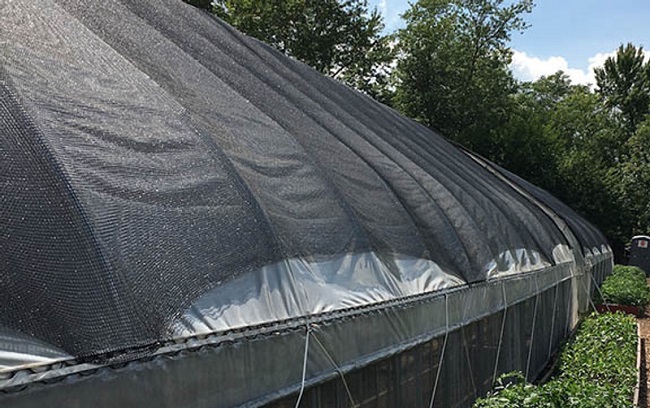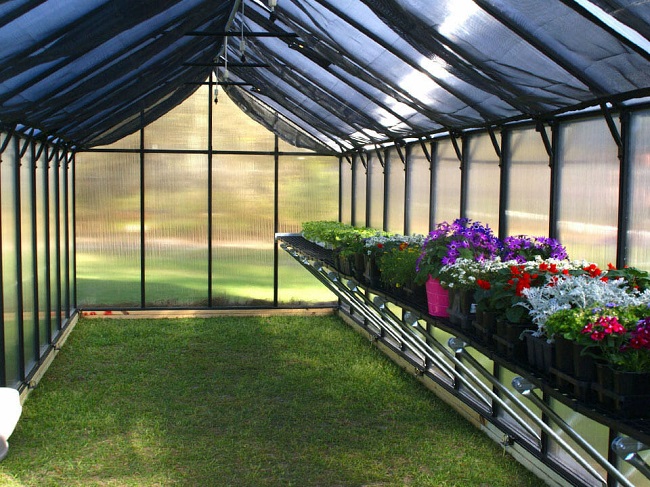The main difference between internal and external shade cloth for a greenhouse is their location relative to the greenhouse structure.
Internal shade cloth is installed on the inside of the greenhouse, while external shade cloth is installed on the outside of the greenhouse. Internal shade cloth is typically made of a lightweight, durable material that can withstand high humidity and temperature conditions, while external shade cloth is typically made of a heavier material that can withstand exposure to the elements, such as wind and rain.
Internal shade cloth provides shade and regulates the amount of light that enters the greenhouse by reducing the amount of sunlight that enters the structure, while external shade cloth provides shade by blocking the sunlight before it reaches the greenhouse. This means that external shade cloth can provide more effective shading during hot weather conditions, while internal shade cloth can provide more precise shading control throughout the day.
Overall, the choice between internal and external shade cloth depends on the specific needs and growing conditions of the greenhouse, as both types have their advantages and disadvantages.

External Shade Cloth
External shade cloth is a type of material used to cover the outside of a greenhouse structure to provide shade and reduce the amount of sunlight entering the greenhouse. This is important in warmer climates or during summer months when excessive sunlight can cause temperatures inside the greenhouse to rise, leading to overheating and plant damage.
External shade cloths are typically made of a durable, UV-resistant material that can withstand outdoor weather conditions. They can be fixed to the greenhouse structure using various methods, such as clips, ropes, or tensioning systems, and are usually adjustable to allow for different levels of shading depending on the weather conditions.
The use of external shade cloth can help regulate the temperature inside the greenhouse, reducing the need for additional cooling systems and energy consumption, and can also provide protection against hail or other environmental damage.
5 Advantages of External Shade Cloth
Temperature Control
External shade cloth helps regulate the temperature inside the greenhouse by reducing the amount of sunlight entering the structure. This can prevent overheating, which can cause plant stress and damage.
Energy Savings
By reducing the amount of sunlight entering the greenhouse, external shade cloth can reduce the need for cooling systems and energy consumption.
Plant Protection
Excessive sunlight can cause plant damage, such as sunburn, dehydration, and wilting. External shade cloth can protect plants from these harmful effects, allowing them to grow healthy and strong.
Customizable Shading
External shade cloth can be adjusted to provide different levels of shading depending on the weather conditions, allowing growers to customize the amount of light that enters the greenhouse.
Protection Against Environmental Damage
External shade cloth can protect the greenhouse from environmental damage, such as hail or strong winds, helping to extend the life of the structure.
5 Disadvantages of External Shade Cloth
Reduced Light Levels
While external shade cloth can be adjusted to provide varying levels of shading, even the most transparent shade cloth will still reduce the amount of sunlight that enters the greenhouse. This can limit the growth of some plants that require full sun exposure.
Limited Airflow
External shade cloth can restrict airflow in the greenhouse, which can lead to stagnant air, high humidity, and increased risk of disease and pest problems.
Maintenance
External shade cloth requires regular cleaning and maintenance to prevent the buildup of debris, which can reduce its effectiveness and lifespan.
Installation Costs
Installing external shade cloth can be costly, depending on the size of the greenhouse and the type of shading system used.
Vulnerability to Weather Conditions
External shade cloth is exposed to the elements and can be damaged by high winds, heavy rainfall, and other weather events, requiring periodic repairs or replacement.

Internal Shade Cloth
Internal shade cloth is a type of material that is installed inside a greenhouse to provide shade and regulate the amount of light that enters the structure. Unlike external shade cloth, which is placed outside the greenhouse, internal shade cloth is installed on the inside of the greenhouse structure.
Internal shade cloth is typically made of a lightweight, durable material that can withstand high humidity and temperature conditions. It is available in various shading densities, from light shade to almost complete blockage of sunlight, depending on the needs of the plants being grown.
Internal shade cloth is installed on the greenhouse framework using clips, wires, or a retractable system, which allows it to be easily adjusted to control the amount of light entering the greenhouse. It can be used year-round to regulate the temperature inside the greenhouse and protect plants from excessive sunlight, reducing the need for additional cooling systems and energy consumption.
6 Advantages of Internal Shade Cloth
Temperature Control
Internal shade cloth helps regulate the temperature inside the greenhouse by reducing the amount of sunlight entering the structure. This can prevent overheating, which can cause plant stress and damage.
Energy Savings
By reducing the amount of sunlight entering the greenhouse, internal shade cloth can reduce the need for cooling systems and energy consumption.
Plant Protection
Excessive sunlight can cause plant damage, such as sunburn, dehydration, and wilting. Internal shade cloth can protect plants from these harmful effects, allowing them to grow healthy and strong.
Customizable Shading
Internal shade cloth can be adjusted to provide different levels of shading depending on the weather conditions, allowing growers to customize the amount of light that enters the greenhouse.
Improved Airflow
Internal shade cloth allows for good airflow and ventilation, which can help reduce the risk of disease and pest problems.
Reduced Plant Stress
Internal shade cloth can reduce plant stress caused by excessive sunlight and heat, improving plant health, and increasing yields.
6 Disadvantages of Internal Shade Cloth
Reduced Light Levels
While internal shade cloth can be adjusted to provide varying levels of shading, even the most transparent shade cloth will still reduce the amount of sunlight that enters the greenhouse. This can limit the growth of some plants that require full sun exposure.
Limited Visibility
Internal shade cloth can limit the visibility inside the greenhouse, making it difficult to observe and monitor plant growth and health.
Maintenance
Internal shade cloth requires regular cleaning and maintenance to prevent the buildup of debris, which can reduce its effectiveness and lifespan.
Installation Costs
Installing internal shade cloth can be costly, depending on the size of the greenhouse and the type of shading system used.
Reduced Light Penetration Over Time
Over time, internal shade cloth may accumulate dust, dirt, and algae, which can reduce the amount of light penetrating through the cloth and affect plant growth.
Potential for Mold and Mildew
If the internal shade cloth is not properly maintained, it may trap moisture and become a breeding ground for mold and mildew, which can harm plants and create health hazards.
Related Articles & Free Email Newsletter Sign Up
7 Necessary Greenhouse Accessories & Supplies




Comment here